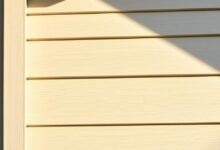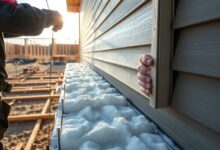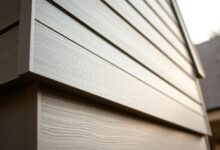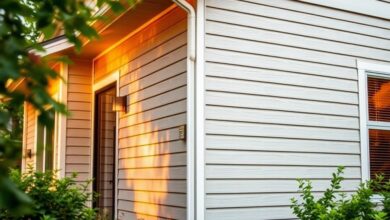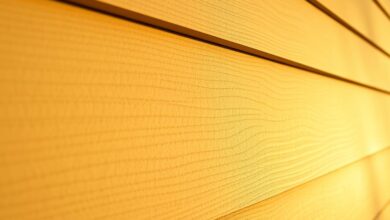Insulated Siding: Unlocking the Benefits
Homeowners are always looking for ways to make their homes more energy-efficient and comfortable. Insulated siding is a great solution. It’s a type of exterior siding that keeps your home warm in winter and cool in summer.
Adding insulated siding to your home can make it much more energy-efficient. This means lower energy bills and a more cozy living space. It’s a smart choice for any home improvement project.
Key Takeaways
- Insulated siding provides thermal insulation, reducing heat transfer.
- Enhances energy efficiency, leading to reduced energy costs.
- Improves overall comfort within the home.
- A valuable addition to home improvement projects.
- Reduces energy consumption, contributing to a more sustainable living environment.
What Is Insulated Siding?
Insulated siding is a modern exterior solution that combines durability with energy efficiency. It provides a complete exterior finishing system. This system protects the home from environmental elements and boosts its energy performance.
The Structure and Components
Insulated siding has several layers: a decorative exterior, insulation, and a backing material. The exterior can be made from vinyl or fiber cement, giving various styles and durability. The insulation, often foam, is key for its thermal performance. It reduces heat transfer between inside and outside.
How It Differs from Traditional Siding
Insulated siding is different from traditional siding. It offers improved energy efficiency and noise reduction. The insulation layer in insulated siding stops thermal bridging. This is a common issue with traditional siding where fasteners can conduct heat, lowering energy efficiency.
The Benefits of Insulated Siding
Insulated siding brings many advantages to homeowners. It improves energy efficiency and durability. These benefits make homes more comfortable and valuable.
Energy Efficiency and Lower Utility Bills
Insulated siding boosts a home’s energy efficiency. It adds insulation, reducing heat loss in winter and heat gain in summer. This can save a lot on utility bills.
Noise Reduction Properties
Insulated siding also reduces outside noise. Its extra layer dampens sounds, making homes quieter. This is great for homes in noisy areas.
Enhanced Durability and Impact Resistance
Insulated siding is durable and impact-resistant. It withstands harsh weather without major damage. This means less maintenance and a longer-lasting siding.
Moisture Management Benefits
It also manages moisture well. By reducing condensation, it keeps homes dry and healthy. This prevents mold and mildew, making homes more comfortable.
Types of Insulated Siding Available
Homeowners have many options for insulated siding. Each type has its own benefits and drawbacks. The right choice depends on your budget, climate, and personal taste.
Vinyl Insulated Siding Options
Vinyl insulated siding is popular for its durability and low maintenance. It has insulation between vinyl siding and a backing. This setup offers excellent thermal performance, keeping homes comfortable year-round.
Vinyl siding comes in many colors and styles. It’s easy to find one that matches your home’s look.
Fiber Cement Insulated Variants
Fiber cement insulated siding is known for its superior durability and resistance to pests and fire. It’s made from cement, sand, and cellulose fibers. The insulation layer boosts its thermal performance, making it energy-efficient.
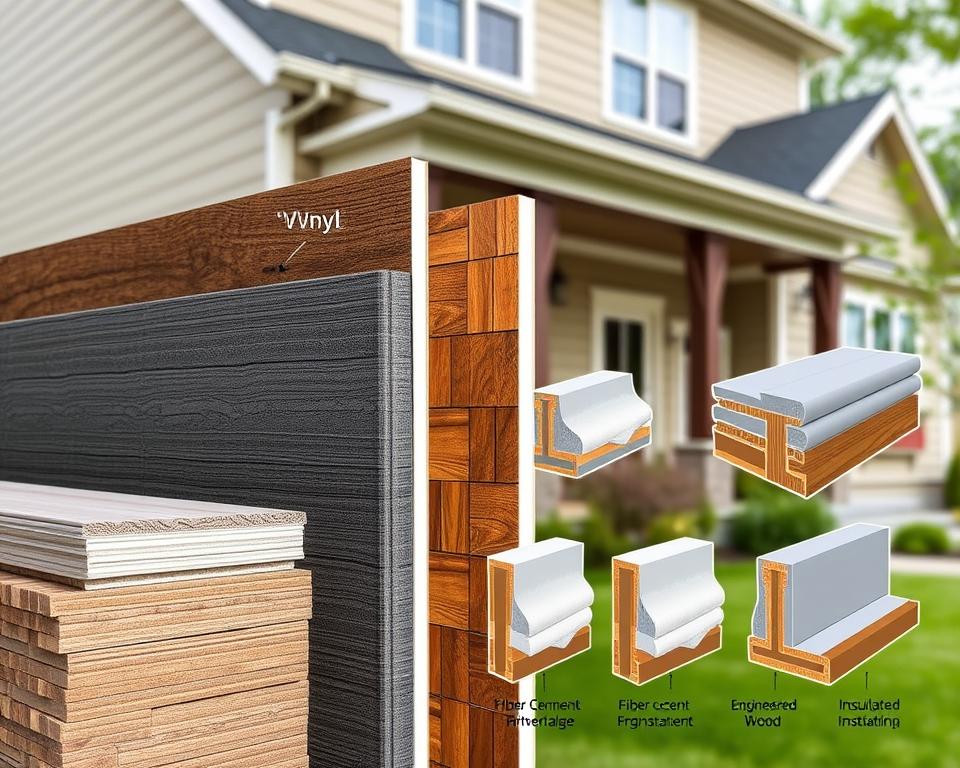
Foam-Backed vs. Integrated Insulation
Insulated siding comes in two types: foam-backed and integrated insulation. Foam-backed siding has foam insulation on the back. Integrated insulation is between the siding and a backing. Foam-backed siding is flexible in insulation thickness. Integrated insulation is streamlined for installation.
How to Choose the Right Insulated Siding
Choosing the right insulated siding is a big decision. It involves looking at different materials, insulation types, and designs. Homeowners need to think carefully to make the best choice.
Climate Considerations for Your Region
The weather in your area is key when picking siding. Homes in hot or windy places need strong siding. Vinyl siding is great for coastal areas because it fights off salt and moisture.
Understanding R-Value and Insulation Performance
The R-value shows how well siding keeps heat out. A higher R-value means better insulation. It’s important to match the R-value with your climate and energy goals.
Color, Texture, and Design Options
Insulated siding comes in many colors, textures, and designs. This lets homeowners pick a look that fits their home. Whether you like modern or traditional, there’s something for everyone.
Manufacturer Warranties and Guarantees
A good warranty can give homeowners peace of mind. Look for manufacturers with long guarantees. These cover both the materials and the work done.
| Feature | Importance | Considerations |
|---|---|---|
| Climate Resistance | High | Material, Thickness |
| R-Value | High | Insulation Type, Thickness |
| Aesthetic Options | Medium | Color, Texture, Design |
| Warranty | High | Manufacturer, Duration |
Installation Process for Insulated Siding
The installation of insulated siding involves several important steps. These steps are key to a successful outcome. They ensure the siding works well, saving energy and lasting longer.
First, the exterior of the building needs to be ready. This means removing old siding and checking for damage. Then, repairs are made if needed. Next, a weather-resistant barrier is installed, followed by the insulated siding panels.
Manufacturers like James Hardie and CertainTeed give detailed guides for their products. These guides help ensure the siding is installed right.
When installing, it’s important to align and fasten the panels correctly. The siding must fit around windows, doors, and other features. Sealing and flashing are also critical to keep water out and the siding in good shape.
Homeowners should hire experienced contractors for this job. They know how to install insulated siding correctly. Knowing the process helps homeowners understand its complexity and importance.
